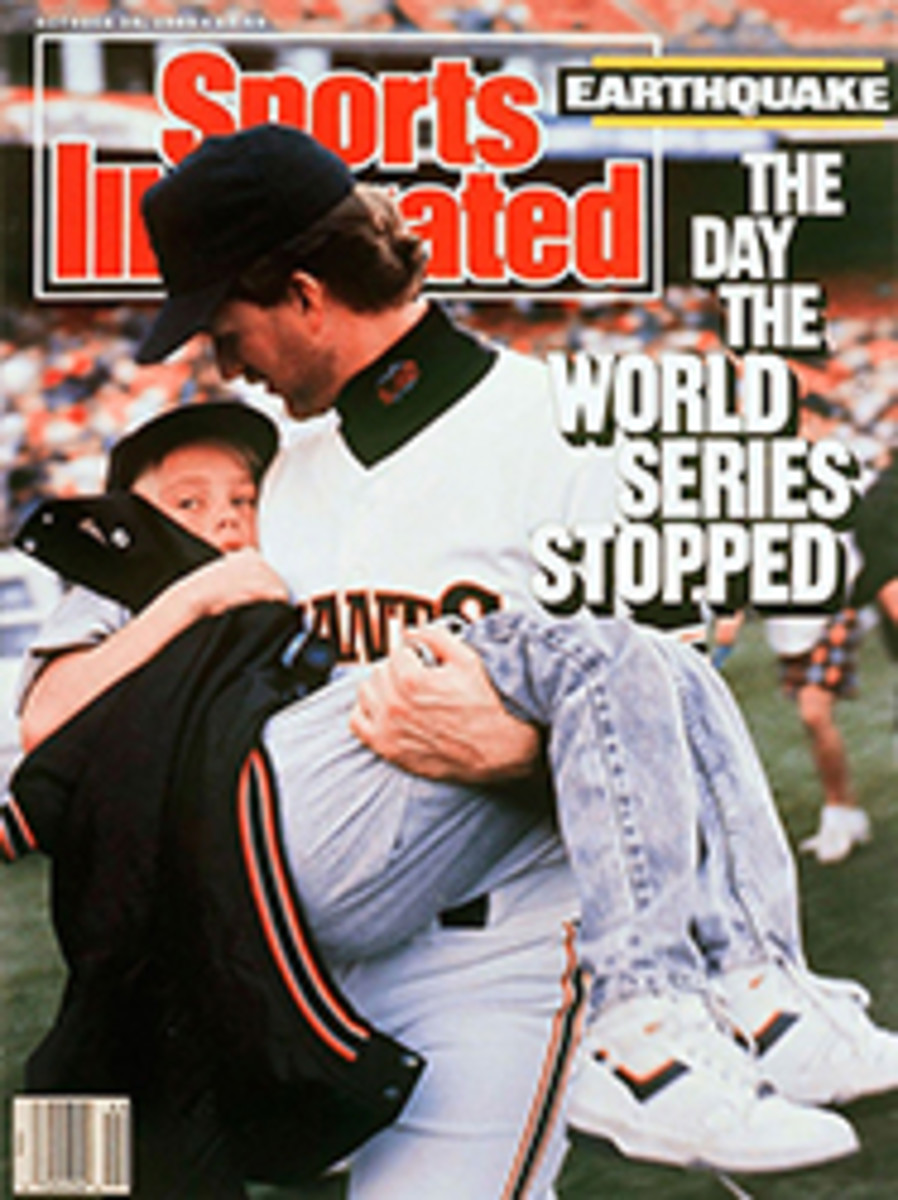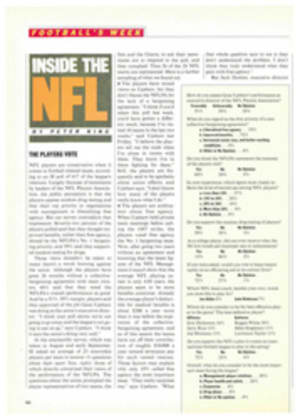
SCORECARD
BRAWLS AND BARBECUES
The athletic mess at North Carolina State is getting even messier. Two weeks ago, police in Raleigh, N.C., charged nine current or former members of the Wolfpack wrestling team with assault in connection with a Sept. 1 attack on two men and a woman outside a town house near campus. The woman was punched in the mouth, and one of the male victims—allegedly struck on the head with a beer bottle—had to undergo surgery for a broken cheekbone and eye socket. Witnesses say the fight began after three wrestlers started urinating on the town-house lawn and the owners and a neighbor told them to leave. At least some of the wrestlers had apparently been drinking.
N.C. State basketball coach Jim Valvano—whose forced resignation as Wolfpack athletic director, the result of a state investigation of academic and other abuses in his basketball program, took effect Oct. 16—didn't tell university officials about the incident for more than a month. The reign of secrecy at N.C. State is evidently dying hard. Until Sunday, the full report of the basketball probe—which cost state taxpayers $40,000—still hadn't been made public. Samuel Poole, vice-chairman of the state university system and head of the four-member commission that oversaw the investigation, had the only remaining copy of the report and refused to release it. He had directed other commission members to destroy their copies. "I burned [mine] on the grill," commission member William Klopman told the Raleigh News and Observer. "I figured since [Poole] told me to do it, I'd do it. It ruined the grill." Finally, on Sunday, threatened with a public-records suit by The News and Observer and other groups, Poole released the report. It was harshly critical of Valvano and offered small but significant details of the violations that have plagued his program.
FORESIGHT?
This week's prize for prescience goes to baseball writer Tom Gage of The Detroit News, whose Oct. 16 story from the World Series began:
"After two losses, the Giants are down to their secret weapon.
"Earthquake.
"Barring seismographic activity which would render Candlestick Park and alternate sites inaccessible before resumption of the World Series on Tuesday, the Giants are in serious trouble. They need more time to figure out how to beat the confident A's."
UPDATE
Less than two weeks after their landmark deal to buy the Denver Nuggets from owner Sidney Shlenker (SI, July 24) had apparently fallen through, Chicago businessmen Bertram Lee and Peter Bynoe secured the financial backing necessary to complete the $65 million purchase. Lee and Bynoe, who will become the first blacks to own a large portion of a major league sports franchise, got help from NBA commissioner David Stern, who last week matched them up with Robert Wussler, head of COMSAT Video Enterprises, a Washington, D.C.-based pay-per-view system. Wussler's company agreed to put up $17 million toward the purchase of the Nuggets and thus will own 62.5% of the team. Lee and Bynoe will contribute $8 million and own 37.5% but will serve as the managing partners. Before COMSAT entered the picture, the deal had nearly unraveled because Lee and Bynoe were relying too heavily on money borrowed from venture capitalists.
HOCKEY MADNESS
Calgary Flame goalie Mike Vernon hardly expected to see a fan in a Canadiens jersey jump out of the stands; after all, this was staid and stately Montreal Forum. But in the first period of the Canadiens-Flames game on Oct. 18, just such a fan ran up the ice toward Vernon and slapped a puck past him into the net with a miniature hockey stick. The crowd roared.
The weirdness at the rink had just begun. Montreal radio station CKMF was sponsoring an outrageous-stunt contest, in which the prize was $21,000, and for some reason all the hockey-minded crazies tried their stunts at this one game. In the second period another fan ran around the ice with a banner that read CKMF. In the third, a guy in a devil costume started climbing over the boards. Referee Andy van Hellemond rushed over and pushed him back into the stands. Get the devil out of here!
Finally, late in the third period, two mountaineers who had climbed to the rafters rappelled down to the ice on ropes and unfurled a CKMF banner. At week's end, CKMF hadn't announced the contest winner, and Calgary coach Terry Crisp, whose team lost 2-1, was still steaming. He griped that van Hellemond had missed a key Montreal penalty while wrestling with the devil. "Everyone needs a little humor," said Crisp, "but, jeez, didn't it get a little ridiculous?"
BIG MOUTH
University of Utah basketball coach Rick Majerus is known for his 300-pound girth and zinging one-liners, but his mouth went out of control the other day on a radio talk show in Milwaukee. Majerus was describing the lack of attention paid to women's college sports: "You know, with women's athletics, my experience has been that there's a great deal of, um—and I'll be frank with you here—there's a great deal of irregular sexual behavior, let me say. And you know, that's never been brought to the forefront. If that were that prevalent in men's athletics...SPORTS ILLUSTRATED [and] TIME magazine would have exposes from now ad infinity [sic]."
Sister Maria Pares, the Marquette women's basketball coach, zinged Majerus in reply when told of his remarks. "I have no idea where he gets his information," said Pares. "I have been coaching for more than 20 years, and nun or no nun, it has been my experience that what he seems to be alluding to is minuscule. If he's talking about the cases of young men who have been brought to trial and indicted for sexual harassment or rape, then perhaps there is irregular sexual behavior."
Majerus later downplayed his comments. "I'm a flippant guy," he said. "I said a hundred things, kidding around. I made a joke about sheep in Wyoming. I said something about passing the microphone and catching a communicable disease. The other night at the roast for [Milwaukee Bucks coach] Del Harris, I'm talking about Del's underwear. What does that mean?"
We probably don't want to know.
BACK FOR ANOTHER FIGHT
George Foreman and Gerry Cooney aren't the only comeback stories in boxing these days. One of the sport's most venerable institutions, The Ring magazine, which earlier this year appeared to be down for the count after 67 years, is back on its feet.
The Ring, the self-proclaimed Bible of Boxing, went into decline after the death in 1972 of founder and publisher Nat Fleischer and the magazine's 1979 sale to a group headed by former New York Knick Dave DeBusschere. In June, with sales having fallen to 25,000 a month (from a high of 130,000 in 1947) and debts nearing $1 million, The Ring ceased publishing. Rumors surfaced that Los Angeles Lakers owner Jerry Buss would buy the magazine, but The Ring found a more fitting savior: 70-year-old Stanley Weston, who bought the monthly from DeBusschere in August.
For Weston, a Rockville Centre, N.Y., publisher of wrestling and boxing publications (among them KO, formerly one of The Ring's chief competitors), the deal was something of a homecoming. As a boy he had raked leaves for Fleischer, a neighbor. After graduating from Long Beach (N. Y.) High in 1937, Weston took a summer job as an office boy at The Ring—and stayed for 14 years. A talented artist, Weston painted 57 Ring covers before leaving in 1951.
When Weston launched the first of his magazines—a monthly called Boxing & Wrestling—in 1953, Fleischer turned against him. "I was blacklisted [in the boxing community] when I left The Ring," says Weston. "I guess I never forgave Fleischer for that. Still, without him I wouldn't be where I am."
In moving operations from The Ring's old offices in Manhattan to Rockville Centre, Weston turned up some 60 file cabinets and 75 boxes filled with old fight photos, clippings and memorabilia. Among the items uncovered were the pen used by James J. Corbett in signing for his 1892 fight with John L. Sullivan, boxing trunks worn by Joe Louis and Rocky Marciano, and the "confession" signed by Jack Johnson saying that he threw his '15 heavyweight title bout with Jess Willard. There were also several of Weston's original cover paintings, including his first, a '39 portrait of light heavyweight champ Billy Conn.
Many of the old photos will find their way into the new Ring, which returns to newsstands this week. Will Weston contribute new artwork? "It's possible," he says, "though most of what I do these days is quite abstract. Still, no matter who I paint, he ends up with a broken nose."
—RICHARD O'BRIEN
PHOTO
KIMBERLY BUTLER
Weston painted covers for "The Ring" 50 years ago; now he owns it.
ILLUSTRATION
PATRICK MCDONNELL
THEY SAID IT
•LaVell Edwards, BYU football coach, on whether he prefers speed or quickness in his receivers: "I'd like to have them both, but if they had both, they'd be at Southern California."

